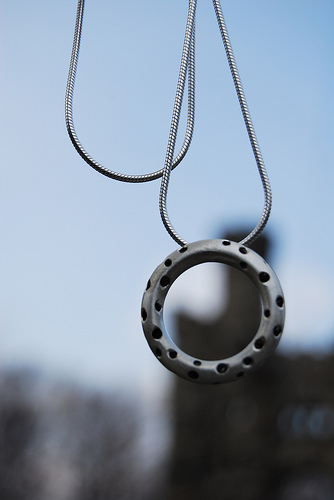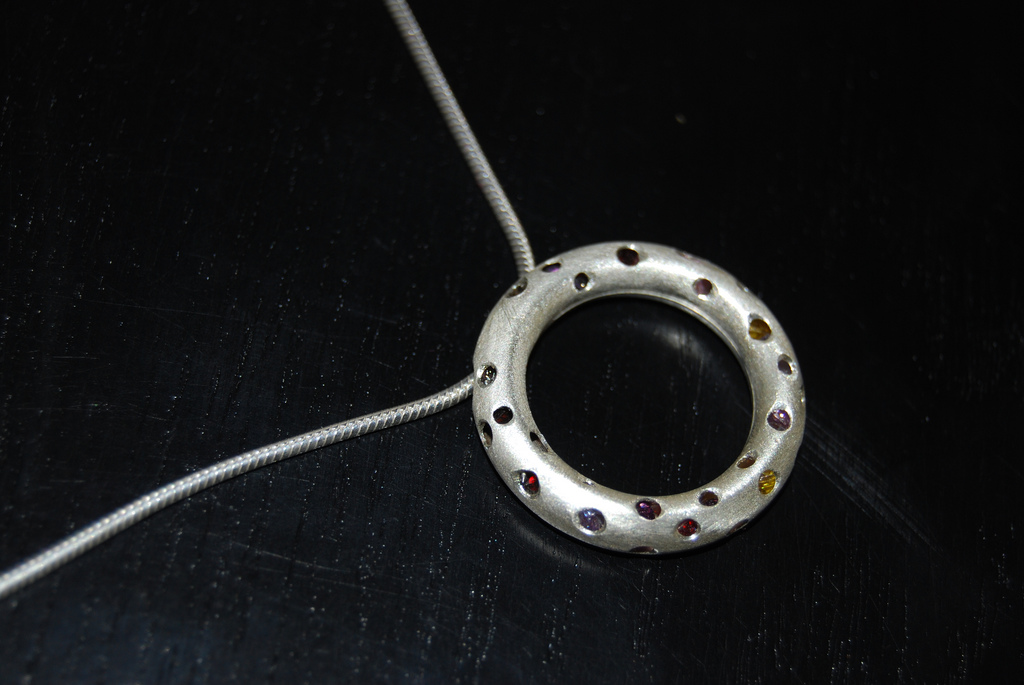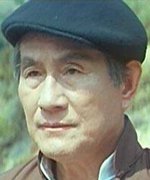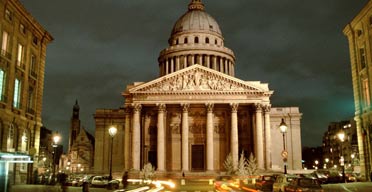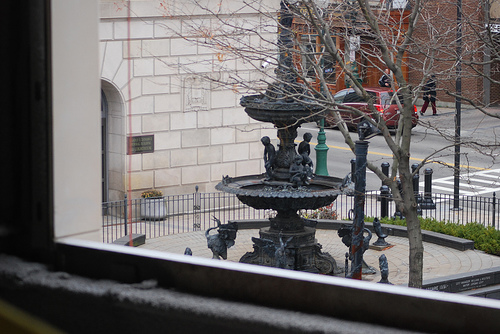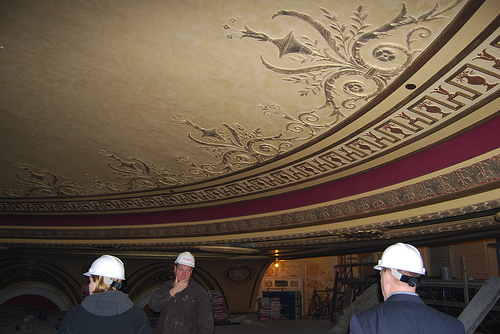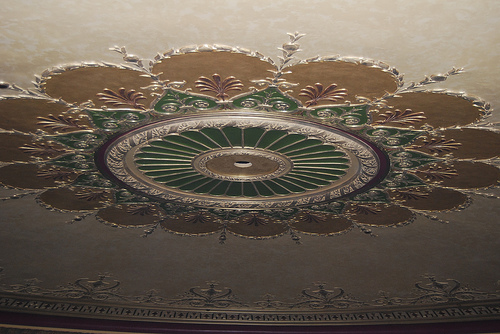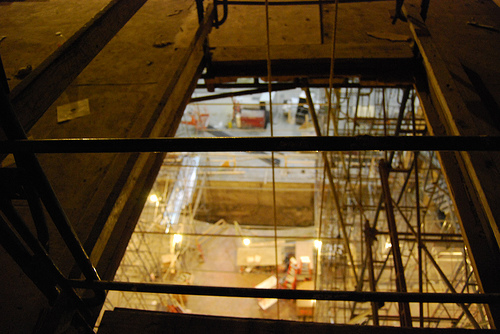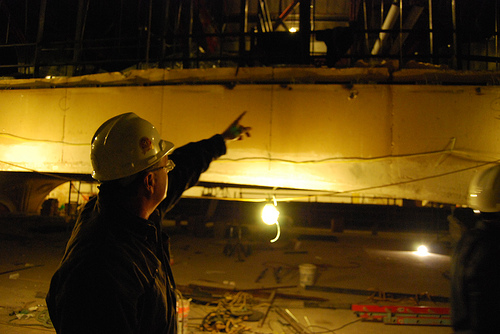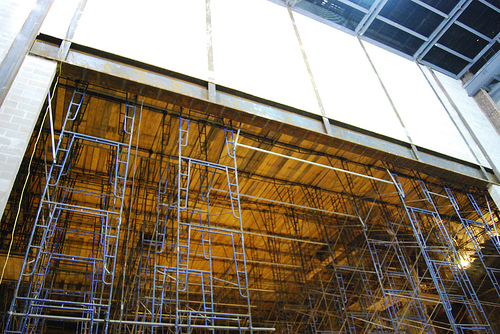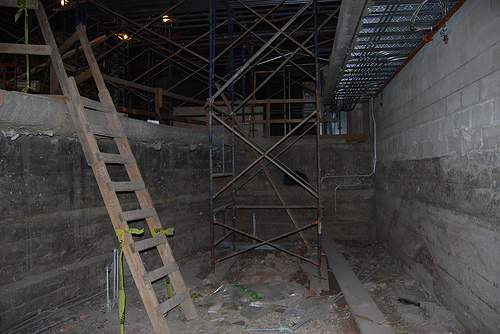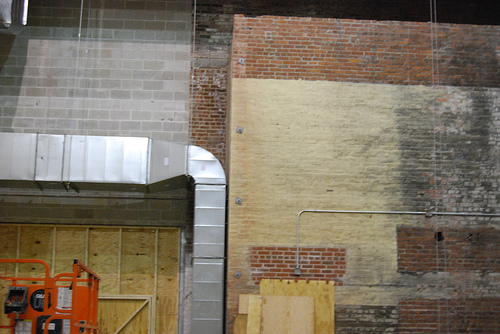The Worcester Cultural Coalition gave an artists grant to Erb Photography for Scott Erb’s idea to shoot a book about Worcester area artists in their studios. He is an outstanding photographer who I met back in 2006 at an Arts Festival in the parking lot of Ralphs Diner.
I was honored when I find out that he wanted to include me in this project.
He came by my new studio the other day and we had a blast collaborating on our ideas for the photo shoot. I absolutely loved his ideas and although I have some personal favorites from the day; I cant wait to see what he’s picked out to use in the book.
To read more about Scott Erb, his work, the book project and get to a glimpse of the artists he’s photographing check out his website at:
Erb Photography
Book Project
Blog about our visit
Author Archives: Cindy
Ploof Studio
For me part of being an artist and loving art is loving art other than your own. I admit I want my own art collection and have begun building it with drawings, paintings, ceramics and now jewelry. I got to check out Chris Ploofs studio a few months back, his designs are based on textures and hard to work materials in metalsmithing.
Keeping this short; I just want to share that Chris made this necklace for me, I really love it and I admire his work.
Click over to his site to see more:
ChrisPloof
Here about his process in this interview on WCCA TV 13
WCCATV13
His designs are available at Neal Rosenblum Goldsmiths on Park Ave in Worcester, MA (877.778.1495) as well as many other galleries all over the country.
Colors of January
Wirrly Works in India
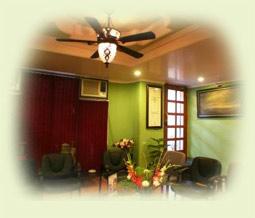
I found this image on the website of my former employer Ajaya Kashyap.
The MedSpa
check out the artwork in the the upper right hand corner of this picture. Thats my painting!
So, Dr. Kashyap sold his practice and moved to India in ’05 and I had always figured he left everything to the new guy. I had inquired about my painting when I heard he was moving but I didn’t get an answer. So all this time I wondered what happened to it; thinking that maybe it had been resold or even discarded…
Now I know, its in his new office in New Delhi India. Kinda cool.
This is the largest I could get this picture to be… so tell me what you think:
Just to the left of the painting, is that a window or a door that will swing open into it? hoping its a window…
For anyone curious; the painting is titled “View from Mt. Monadnock” measures 2′ x 4′ executed in oil on panel in 1997. I still have the charcoal prep drawing I did for it, framed and hanging in my home.
Assignment: A paper about a martial artist
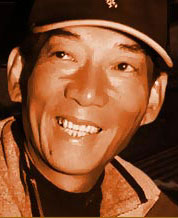
Yuen Woo-Ping
By Cynthia Woehrle
When I found out about this paper and considered who to write about I realized there was one person who I had always wanted to know more about: Yuen Woo Ping. He is a very well known fight and action choreographer; so I wondered, where is his training based, what are his influences, what style of kung fu did he practice, how did he enter the industry?
Here’s what I found out:
Yuen Woo Ping trained at the China Drama Academy under Master Yu Jim Yuen. The China Drama academy was part of the Peking Opera School. Generally students are hand picked at an early age by a sifu and are boarded at the academy. Attending students learned Peking Opera, Martial arts, acrobatics and tumbling and performed these skills for audiences. Many of these schools had closed down after the Japanese invasion in 1931 but the China Drama Academy opened after the war in approximately 1950. Peking opera schools were well known for their harsh rigorous training methods in which the entire group of students would be beaten with bamboo canes for one students mistake during a performance. It is said that the schools that opened after the war were less harsh than previously.
The China Academy produced many students that went onto successful careers in Hong Kong cinema. Such as Jacky Chan, Sammo Hung, Yuen Biao, Yuen, Wah, Corey Yuen, Yuen Qui and of course Yuen Woo Ping. To tell you that anyone of these people trained at the China academy means that they lived breathed and ate training. Generally the day started at 5 am for morning exercises. (Jacky Chan had been quoted in saying that Yu Jim Yuen did not allow students to use the bathroom until the lunch break; the theory being that any toxins in the body would be flushed out in sweat during these exercises.) The remainder of the day would consist of learning skills in acting, weapons, kung fu, stretching, combat, acrobatics and performing. These performances served as income for the school and as also paying the debt the students accumulate during their stay for expenses of food and accommodations. Training took place up to 18 hours a day. All this was part of the contract the students made with the school generally these contracts were for ten years of training and living at the academy. The film “Painted Faces” was based on Master Yu Jim and although it is told from the perspective of Jacky Chan and Sammo Hung’s generation of students it is still able to reflect the training, society and influences that all students Master Yu Jim had, including Yuen Woo-Ping. Master Yu Jim is known also as a northern kung fu practitioner. Many of his students took on Yuen as their sur-name, which is a tradition. I have found information also that Yuen Woo-Ping’s father was also a huge influence on his training – more specifically in the aspect of Kung Fu.
Woo-Ping (meaning Peace) was the oldest of 12 children. He was born in 1945 in Guangzhan China and his father is Yuen Siu Tin. Yuen Siu Tin also trained at the China academy under Master Jim where he graduated to the level of instructor, had a long career with the Peking Opera and was known as an expert. After his graduation Siu Tin taught Kung Fu in Guangzhan. He also performed in black and white Cantonese Custom dramas; credits list him appearing over 100 of these dramas before starting his movie career. It was Siu Tin’s reputation and regard in the industry that helped enable Woo-Ping to launch his career. Actually, five of his children went on to have successful careers in Hong Kong cinema. Siu Tin was cast as a sifu to a young Jacky Chan in “Snake in the Eagles Shadow” (directed by Woo-Ping) this role also boosted his career and he became famous in this genre in 1978 at the age of 67.
That said; Woo-Ping had a deep-set family tradition in Kung Fu, performance, and the film industry. Unfortunately at the time of writing this paper I was unable to discover what style of Kung Fu Woo-Ping and his father practiced and taught. Yuen Woo-Ping carried over his extensive training in Kung Fu and Chinese Opera into an amazingly successful career as a choreographer and director. So, no biography about Woo-Ping would be complete with out an overview of his career.
Woo-Ping started his career after being introduced to the producers of the Wong Fei Hung series in the late 60’s. He developed his film stunt work more when he started working with the Shaw brothers. In 1971 he gets his first credit as a choreographer with the movie “Mad Killer” directed by Ng See Yuen. Ng and Woo-Ping work together again in “Snake in the Eagles Shadow and Drunken Master”
Many of Woo-Ping’s films are favorites amongst fans of Kung Fu movies, whether he has acted in the film, directed it or choreographed it. I believe a lot of this is a testament to the training that was instilled in him when he was younger. It seems as though many elements came together in a unique way for this generation of China Drama Academy. First consider the original intention for training at the drama academy; yes it was for performance but not necessarily for film performance. The film industry has been continually changing and progressing over the past 100 years. I feel that Woo-Ping entered the industry at a great time of opportunity when there was a surge of projects and interest in kung fu films. Hong Kong Cinema – one of three major threads in the history of Chinese language films, alongside Cinema of China and Cinema of Taiwan. It was in the late 60’s that Hong Kong Cinema grew to be the third largest motion picture industry in the World. Its success is due in part to political and economic freedom Hong Kong had from Mainland China. They also became the second largest exporter in the industry in the world. I am sure that there was a lot of competition from other graduates of the Peking Opera schools around the country, and that a few connections in the industry helped him get in but I would not use that question as criticism towards someone who’s career never stopped. Once in he stepped up and did the job. The work ethic and motivation to continually put out movie after movie and to also push the genre is very admirable. He was able to make an impact not only through his skill as a martial artist but as well as being able to convey his vision to actors, stunt men, film crew and other performers and have that vision conveyed through film to an eager audience. Over the course of a 40-year career one would hope to contribute something of substance to what they do. Woo-Ping has certainly done that and has raised the bar for future action film directors.
It would be very cumbersome to analyze all the films he’s done. So I would like to present a few films that represent different stages of his career.
Early films; like “Snake in the Eagles Shadow” “Drunken Master” dating 1978; are in the classic Kung Fu movie style. These are period films that have story lines set in Kung Fu schools demonstrating the students training and development through overcoming obstacles in a certain style as well as personal challenges. These movies reflect a history to kung fu in china (although they may be loosely based on fact and more on legend) the stories of Kung fu are filled with rivalries, revenge, and honor and of course the fight scenes. What fans appreciate about Hong Kong Cinema fight scenes is the physicality behind the stunts the intent and strength in the movements and combinations in the fight scenes; and of course the talent of the stars performing these stunts.
I find his mid career films to be in the early to mid 90’s. “Wing Chun”, “Iron Monkey” and “Once Upon a Time in China” and “Fist of Legend” are all historical films telling the stories behind heroes in Chinese culture- that also did kung fu. It is shortly after this time that Hong Kong was returned to Chinese sovereignty and there was a crisis in the industry about the effect that would have. Despite this major political change Hong Kong Cinema has been able to retain its individuality. It is also in the late 80’s and 90’s that “wire work” in the stunts and fight scenes were utilized in the films. This presented more of a supernatural or super human element to the capabilities of the characters a huge difference when you compare that a character can just naturally fly to the early films that conveyed the grueling training the characters did to achieve their skills.
It was “Fist of Legend” that grabbed the attention of American filmmakers the Wachowski Brothers and they hired him as choreographer for The Matrix. The Matrix is a sci-fi film based in the future. Previous to this film Hong Kong Cinema genre had a strong cult following but the success of “The Matrix” and then the international success of “Crouching Tiger, Hidden Dragon” has taken that following to a more mainstream status in the U.S.
These break through movies in the late 90’s to today has brought him to the American forefront as the most desirable action choreographer to work with and he was subsequently hired to work on Quentin Tarentino’s Kill Bill’s and then the Matrix Sequels. At this time I would like to note the difference In the “wire work” stunts in “Crouching Tiger, Hidden Dragon” and “Hero” 2006 as compared to “Fearless”. The first two films from 2000 and 2002 are epic and beautiful and although there are great hand-to-hand combat scenes the fantasy like “flying element” is still predominant through out the films. The characters engage in battle in the air, on top of trees, can scale walls, all these things are visual eye candy and awe inspiring to the viewer. “Fearless” on the other hand only used the wirework in quick mid air turns. Ryan Pearson described this well when he wrote: “During one fight, Jet Li is knocked off a tall platform. While nearly horizontal, he grabs its edge and flips himself back on. When he’s pushed from a boxing ring, he grabs the top rope with a hand, and puts a foot on a post to bounce smoothly in the opposite direction; such moves are brief and powerful. They require suspended disbelief for just a split second. Then it’s back to the brutal, more realistic on-the-ground battles, where Yuen and Yu focus on Li’s expert footwork.”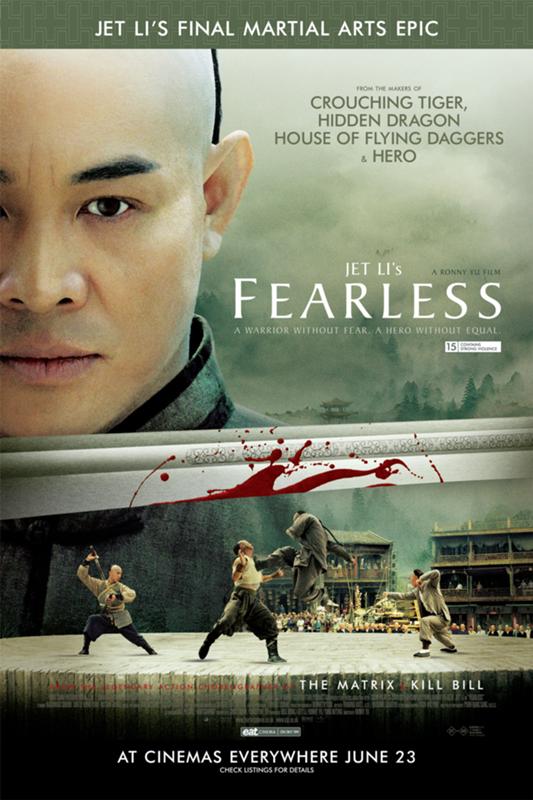
Woo-Ping has worked with actors at the onset of their careers who have gone on to also achieve awards an acclaim for their work in film. Such as Jet Li, Michelle Yeoh, Donny Yen, Jacky Chan. His collaborations in the industry have paired into many other projects. Quentin Tarentino helped to bring the film “Hero” to the US big screen; this film featured a fight scene between Jet Li and Donny Yen, who had not been filmed together since “Once Upon a Time in China”. His father Yuen Sui Tin was in many films, mentored Jacky Chan after they worked together in “Drunken Master”, Sui Tin was featured in 35 more films during his lifetime. In 1979 the “Drunken Master” role was reprised for the movie “Magnificent butcher” – this time paired with Sammo Hung and also directed by his son Woo-Ping. Sui Tin died of a heart attack partway through the filming of this movie; the part was recast and his scenes re-shot. Jacky Chan of course has achieved superstar status and is the most well-known martial arts actor in the world, it is said that Sui Tin help Jacky develop the on screen antics and stunt work that he became known for.
Considering all the inter-connections between the stars, the directors and the choreographers; Hong Kong Cinema appears to be a very small and tight knit industry. But now that Woo-Ping is more internationally known his influence has “shaken up” the expectations of American audiences. They want to see their actors perform more than two moves before being edited from another angle, there is far more appreciation for the skills being displayed on the screen. For instance the “Kill Bill’s”; where Woo-Ping was the action choreographer and fight adviser; was seen as having intentionally over the top violence from the perspective of American Film perspective but also was regarded a tribute to Hong Kung Cinema and the revenge genre. This film certainly offered something new to the American audience and of course Tarentino’s pairing with Woo-Ping has contributed to the raised expectations of the western audience as well appreciation for the martial arts aspect of films.
His peers regard Woo-Ping as a Master and he is held with utmost respect, which I believe he has earned. His newest project “The Great Wall” is now in production and I look forward seeing where he takes the style of fight choreography and stunt work that he presented in “Fearless” an “Unleashed”.
Over heard in Worcester
“I respect a man who doesn’t waste a lot of headroom on interpersonal problems. It must be nice to not have a conscience…”
Undercover restorers fix Paris landmark’s clock
Paris Pantheon
They let themselves get locked in
Set up a studio underneath the dome- planks of wood, table, chairs, tools all snuck in from a side entrance after picking a lock. They even set up a computer and internet service up there.
Consequence?
An antique clock is restored
Officials press charges but these “cultural guerilla’s” are cleared of any wrong doing
The Administer of the building loses his job.
Cant imagine what would have happened to these guys if homeland security caught them in this country. Probably would have been reminiscent of the Cartoon Network fiasco in Boston.
“For a year from September 2005, under the nose of the Panthéon’s unsuspecting security officials, a group of intrepid “illegal restorers” set up a secret workshop and lounge in a cavity under the building’s famous dome. Under the supervision of group member Jean-Baptiste Viot, a professional clockmaker, they pieced apart and repaired the antique clock that had been left to rust in the building since the 1960s. Only when their clandestine revamp of the elaborate timepiece had been completed did they reveal themselves.”
Read the rest of the article
Hanover pushes forward
The other day I took a tour of the Hanover Theatre for the Performing Arts renovations in downtown Worcester. To me it was a bit of a now or never situation because the scaffolding to the ceiling was coming down on Saturday (the 24th) and I wasn’t going to pass by the chance to see the restored ceiling up close. Ok, so I’ll admit I’m a bit of a history geek, an art geek and a sucker for documentaries about restoration projects; be it This Old House or The Sistine Chapel. So I was pretty excited to put on my hard hat and walk behind the chain link fence surrounding the property at Federal Square.
This was my second time in this building- not being a Worcester native I had only seen one movie here before the Loews Poli Theater closed down. (was it a Loews or a Showcase? I’m finding information saying both) The movie was Dark City and I remember feeling the building was as surreal as the film I was watching, its weathered late 60’s decor, old creaky seats, sparse attendance. I compared the building to Cabot Street Cinema in Beverly Mass the theater that I frequented in college, it was warm, comfortable, and well maintained; what a stark contrast between the two places. I had just moved to Worcester and I really didn’t know what to think about the downtown area, I’ll say that I didn’t see many reasons to venture down that way again. First impressions last a long time and it wasn’t until Start on the Street threw its first festival on Main Street that this area caught my attention again.
So here I am nearly ten years later getting a tour of this impressive project.
History:
First built as a small theater in 1904 and expanded in 1925 ; was taken over by National Amusements in 1967 and converted to the theater I experienced in 1998; closing shortly afterward. In 2002 Worcester Center of Performing Arts acquired the space and started planning the restoration to the theaters 1925 elegance. You can read the rest of the details by following the link above.
The tour in pictures:
 The old facade is behind the scaffolding. The building is on the National Register of Historic places. The plywood you see is in place of the stained glass. Unfortuately the glass was too damaged to be restored. Hopefully down the road it will be replaced but I was told that it’s not in the budget for now….anyone want to gift a new stained glass window? 🙂
The old facade is behind the scaffolding. The building is on the National Register of Historic places. The plywood you see is in place of the stained glass. Unfortuately the glass was too damaged to be restored. Hopefully down the road it will be replaced but I was told that it’s not in the budget for now….anyone want to gift a new stained glass window? 🙂
To the right of the scaffolding is the new facade. which will be all glass and overlook Federal Square.
View of Federal Square
A piece of wall detailing the color scheme from the 1925 additions. These colors are being used on the restored ceiling. These walls were completely unstable and are being torn down- you can see new new drywall on the left side of this photo.
The tour reaches the ceiling:
Pictured here (L-R) is my tour buddy Donna from Erb photography and our tour guides Steve from Barr and Barr Construction and Kallin Johnson from the board of Trustees of the Performance center. You can see here the scale of the ceiling that we are standing under. the ceiling had been completely repaired with 20% of it being reconstructed. This is a suspended ceiling and was crafted on site during the 1925 additions.
Center detail of the ceiling. Here you can see the gold red and green colors that were carried over from details found in the theater. A chandelier hangs from the center which is currently off site being restored.
The round flower at the top of this picture is accented in real gold leafing. you can also see here that there is still some painting left to do but the flooring is blocking the wall. once the scaffolding is down the details on the upper wall can be completed.
Standing above the auditorium.
Here there was an access point looking down into the auditorium. The half circle at the center of the picture is the Orchestra Pit.
Kallin points out details above the suspended ceiling.
There is a cat walk on top to access the lighting, heating, duct work and other units that were installed to modernize the theater. The white part of the wall is a cross-section of the ceiling this will be extended to curve down to the top of the stage (which you can see below). Once constructed the space where we are standing will not exist and the only access to the ceiling will be the cat walk above.
Ceiling with scaffolding viewed from the stage.
Under the stage and access to the orchestra pit
Old and new
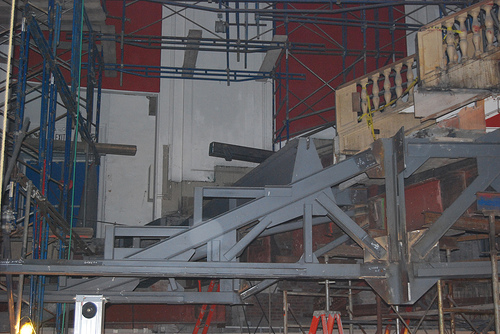
This picture depicts the hand railing for the mezzanine seating plus the new supports. Five more of these “arms” are being installed; weighing at about 10 tons each.
To the right is the original building in brick to the left is concrete that is the extension of the building. The original stage was five feet shorter on this side. During the current expansion the entire stage was extended to 40 feet deep. This size will accommodate the touring Broadway shows that are being booked for the theatre.
Its impressive to see the “guts” of the building during this project. I am certain that much of this has already transformed since I took my tour on the 21st.
This project is pushing forward at full speed and will be opening in March. Yup, March just a few months away. I encourage anyone to go down and check out this project, the engineering, artistry and professionalism behind it is truly impressive, and its encouraging to see something so culturally vital and active happening in downtown Worcester. I couldn’t possibly completely reiterate all the information the Kallin and Steve shared with us during the tour. Many thanks to each of them for everything that they have done to make this theater happen and for taking the time to show me around. I left them feeling very positive about whats happening downtown, this is a huge step towards revitalizing the area and I hope that the theaters progress will encourage the City Square project to pick up momentum.
Public tours happen every Wednesday at 5:30.
You can view more pictures from this tour by visiting my flickr site here.
Heres a list (borrowed from the website) of the Major Renovations.
The major renovations include:
- Removing earlier cinema alterations and reconfiguring seating arrangements;
- Restoring the stage and proscenium wall;
- Installing elevators for access to all lobby, stage and back-of-house areas;
- Installing a new orchestra pit, workrooms, access and loading areas;
- Upgrading mechanical systems and installing state-of-the-art lighting and sound systems;
- Upgrading building code requirements: exits and access;
- Replacing the roof and new insulation for energy efficiencies;
- Restoration of the historic lobby area and re-opening of the 2nd floor mezzanine; and
- Construction of a new, glass pavilion lobby overlooking Federal Square
Light the Lights Campaign
If you would like to help support the theatre please follow this link to make a donation.
Thoughts on Thanksgiving
Nov 21st: The Biggest Bar Night of the Year, or so I keep hearing. Possibly even bigger than New Years Eve. I suppose I’ve never heard of a Thanksgiving Eve party so what else is there to do when you’ve finished baking, traveling, and running around preparing for Turkey Day? Some sarcastically say they “need a few drinks” to help prep them for a full day of family time. But Really, its a four day weekend (that only happens once a year) you deserve to meet up with friends and have a couple drinks to it kick off.
So how are you gonna spend this big party night? Theres a bunch of hip things happening around the Worcester bar scene, just look here.
If your staying in Worcester tonight it would be a shame to miss those shows.
I’ll be at BaBa working the closing shift and hanging with my BaBa family and a few favorite regulars.
So, theres a pitch for going out the night before Thanksgiving but what is this all about? The biggest traveling day of the year, biggest bar night, biggest shopping day, biggest national holiday? Is it all in the name of family? What does Thanksgiving really mean? “Modern Day” Thanksgiving means family togetherness, taking a moment to appreciate the things you have, eating too much turkey, watching football and planning ahead to hit the big sales the next day. Sounds a little cliche doesn’t it?
“Modern Day” Thanksgiving to me is about being with my family and feeling nostalgic about those family traditions that have been kicking around since I was a kid. This year its also about change and noting anniversaries. The first Thanksgiving since a loved ones death; missing the traditions that had included them. Like watching the dog show while snacking on appetizers and getting the food on the table. Remembering scenarios that will not happen again.
Yesterday morning I met the father of a little boy who had died over the weekend. He smiled and shook my hand. Upon receiving my condolences, he explained to me how he was thankful for the 7 years that he was able to spend with his son. In facing loss he found a poignant way to remember him. Life is precious and sometimes short. On this holiday he and his family will also be on my mind. Situations like this cut through whatever cliches commercialism has imposed on the holidays. Life changes. What better way to honor past good times with loved ones than to continue to Live?
Toast with your friends tonight. Have a good time and Celebrate the people you love.
A Moment to Promote Fire and Ice
I’ll have two pieces in the show.
Sizzler at the Aurora
Fire and Ice 2007
ARTSWorcester Members Winter Exhibition and Sale
November 16 through December 19, 2007
Join us for a festive opening reception on Friday, November 16, 2007 at ARTSWorcester for Fire and Ice, a Winter Members Show. Over fifty artists will exhibit works in many different types of media. Live music will be provided for the evening by Chet Williamson and by the ARTSWorcester Jazz Ensemble. A silent auction and a live art auction will take place with celebrity auctioneers, including Worcester Mayor Konnie Lukes, James Welu of the Worcester Art Museum, State Representative Robert P. Spellane, and others. All artwork will be for sale so shop early for the holidays. It’s going to be a hot sale on a cool night!
The opening reception will take place Friday, November 16, 2007 from 6:00 PM – 9:00 PM at the Aurora Gallery. Silent Auction will take place between 6:00 PM – 8:00 PM and the Live Auction will occur between 8:00 PM and 8:30 PM. Tickets for the opening reception are $25.00 per person.
Artists on display include: Eugene Albrizio, Raymond Army, Lisa Barthelson, Eleanor Beatty, Ed Bissell, Emily Boosahda, Lora Brueck, Bill Caloccia, Susan Champeny, George Cooley, Donna Conroy, Linda Dagnello, Jessica DeHaemer, Andrea Driscoll, Mary Dunn, Eugene Epstein, Scott Erb, Jenn Falcon, Cindy Lee Fedeli, Andres Gilardo, Igor Gurbanov, Robert Gilfoy, Ginney Gillen, Darlene Haddad, Brian Higgins, Scott Holloway, Nicole Hutchinson, Howard Johnson, Timothy Johnson, Susan Kenney, Jesse Knott II, Sam Lalos, John LaPrade, Cheryl Litchwell, Susan Lozoratis, Dalton Lugo, Dominick Marcigliano, Maggie McCauley, Phil McGourty Gilman, Carlotta Miller, Christopher Moniak, Robert Morey, Allen Palmer, Matt Patterson, Joan Paulson Gage, Reynald Poisson, Christina O’Neill, Jacqueline Ross, George Sampson, Dawn Scott, Mary Shepherd, Niva Shrestha, Jack Sikes, David Snay, Sid Solomon, Zoey Stites, Susan Stuart, Leonard Stokwski, Louis Swinand, Susan Swinand, Katherine Taronas, Troy B. Thompson, Mihoko Wakabayashi, Edward Watson, Jill Watts, and Christopher Whitehead. (as of 11/6/2007)
|
|
